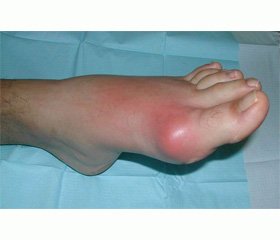Международный эндокринологический журнал 3 (59) 2014
Вернуться к номеру
Peculiarities of clinical manifestation, course and treatment of patients with gout associated with hypothyroidism
Авторы: O.I.Voloshyn, O.I.Dogolich, N.V.Pashkovska - Bukovinian State Medical University, Chernivtsi, Ukraine
Рубрики: Эндокринология
Разделы: Клинические исследования
Версия для печати
Nowadays gout is recognized to be not only one of the most important rheumatic diseases, but a general medical problem as well. Recently gout has been considered to afflict men mostly (7–8 : 1), but in the late decades this ration has been changed to 5–7 : 1. Age peculiarities of the disease development are registered involving the formation of increasing polymorbidity, comorbidity and causing certain difficulties in diagnostics, treatment and prevention. Hypothyroidism is one of the diseases consisting of a polymorbid ground in case of various pathologies and changes its features. The problem of hypothyroidism has become one of the main subjects of present day clinical trials in various fields of medicine. Epidemiological examinations are indicative of the fact that frequency of this syndrome on a global scale has increased achieving the population level of 2 %, and it is found in an obscure form in 10% of the adult population, although among women it is found 3-9 times more often (to 21 %) than that of men, especially at the age from 50 to 60. Hypothyroidism is universally recognized to develop slowly and obscurely, it can mimic other diseases and affect functions of all the organs and systems. As to the influence of hypothyroidism on clinical signs of different comorbid diseases, this problem is a subject of a number of scientific researches during the late decades. Special attention is paid to a low diagnostic level of this pathological condition by different medical specialists including therapists. Concerning gout these examinations are collateral, descriptive or built on inadequate clinical evidence. Although, both hypothyroidism and hypouricemy associated with gout and they are one of the important factors increasing cerebral and cardio-vascular risks. Considering a certain similarity of epidemiological age tendencies of the development of gout and hypothyroidism, alimentary factors of their realization, an attempt to study clinical manifestation and ways of correction of gout against hypothyroidism has been made.
Materials and methods. 127 patients with gout aged from 37 to 77 have been examined; men prevailed (98 individuals – 77.16 %). An average age was 57.7 ± 4.56 years, and the majority of patients was older than 55 years (99 individuals – 77.95 %). The diagnostics of hypothyroidism was made according to the recommendations of Ukrainian and foreign scientific centres by means of detection in the blood serum TSG levels, free Т3, Т4 using immune-enzymatic method, antibodies to thyroid peroxidase if needed, as well as USG of the thyroid gland, its palpation and analysis of possible complaints. Considering the recommendations of the American Thyroid Association subclinical hypothyroidism was diagnosed when TSG in the blood serum was higher than 4.3 to 10.0 mUn/L, and higher than 10.0 mUn/L – manifested hypothyroidism in spite of minimal clinical signs and not always reduced level of Т4.
The diagnosis and stage of gout was detected according to the criteria recommended by the American Rheumatoid Association (2004). Biochemical examinations (level of uric acid, creatinine, cholesterol, triglycerides, urea, bilirubin fraction, glucose in the blood) were performed on the automatic analyzer Ultra Кone (Finland). The period of exacerbation of gout arthritis of various degree and spread was registered in all the patients. The control group concerning biochemical blood indices included 20 practically healthy individuals of the same age.
Statistical analysis was conducted by means of the set of applied programs Microsoft Exeel 2003, Statistica for Windows (Stat Soft Inc). The results were statistically valuable in case of p < 0.05.
Results. The signs of subclinical and manifested hypothyroidism were found to occur in 19.25% cases of the examined patients, and they were 2.3 times higher in women than those in men. Both forms of hypothyroidism worsen the course of gout, promote its progressing, reduce the efficacy of treatment and formation of increased polymorbidity. Early diagnostics of hypothyroidism in patients at the age from 50 to 55 is introduced, or it may be applied for younger age in case of intensified gout signs, which in its turn aggravates the course of the disease. Administration of Levothyroxin (manifested hypothyroidism) and Zobofit phytocomplex in the treatment of gout improved clinical dynamics of polymorbid ground, the signs of thyroid homeostasis, lipid homeostasis and glomerular filtration rate.
Conclusions.
Subclinical and manifested hypothyroidism worsens the course of gout, promotes its progressing, reduces efficacy of treatment and increases polymorbidity.
Early screening-diagnostics of hypothyroidism is reasonable in people with gout older than 50–55 years or in young people with intensified clinical signs and aggravation of the course.
Administration of Levothyroxin in case of manifested hypothyroidism and Zobofit phytocomplex in the treatment of gout promotes regression and response to pathogenetic therapy of comorbid diseases, thyroid homeostasis, lipid homeostasis and glomerular filtration rate.

